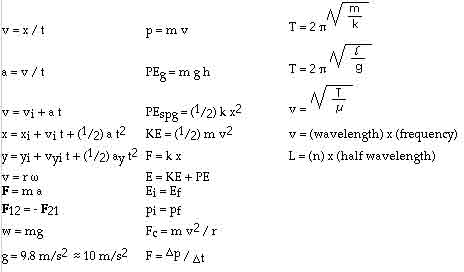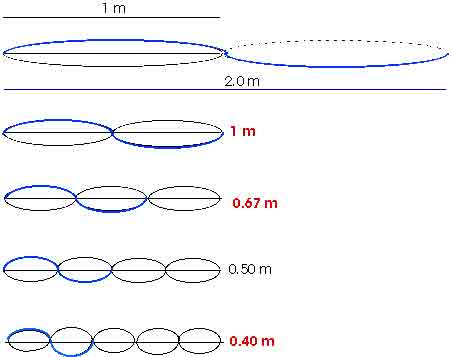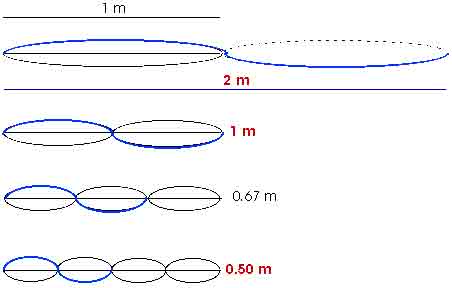For every question, also consider as a possible answer
E) none of the above
Possibly useful information:

Excursions in Physics
Excursions Live!
Third Hour Exam
May 24, 2001
For every question, also consider as a possible answer
E) none of the above
Possibly useful information:

For every question, also consider as a possible answer
E) none of the above
1. Decreasing the mass of a simple pendulum harmonic oscillator makes its period
A) longer
B) shorter
C) unchanged
2. Increasing the spring constant k (that is, using a stronger spring) in a
mass-and-spring simple harmonic oscillator makes its period
A) longer
B) shorter
C) unchanged
3. Increasing the mass m of a mass-and-spring simple harmonic oscillator makes
its period
A) longer
B) shorter
C) unchanged
4. A mass-and-spring simple harmonic oscillator has maximum kinetic energy
A) at its equilibrium position
B) when its displacement equals its amplitude
C) half way between equilibrium and amplitude
D) three-fourths of the way between equilibrium and amplitude
5. A mass-and spring simple harmonic oscillator has maximum potential energy
at
A) its equilibrium position
B) when its displacement equals its amplitude
C) half way between equilibrium and amplitude
D) three-fourths of the way between equilibrium and amplitude
6. The frequency of a simple harmonic oscillator is
A) the time required for one oscillation
B) the number of oscillations per second
C) the energy stored in the oscillations
D) the maximum distance moved from equilibrium
7. The frequency of a certain oscillator is 100 Hz; its period is
A) 0.1 s
B) 0.01 s
C) 0.001 s
D) 0.0001 s
8. There are "signals" of many different frequencies coming into the
antenna of your radio. Only the one with a particular frequency is amplified
and produces the sound you listen to. This is an example of
A) resonance
B) damping
C) timbre or quality
D) fundamental regeneration
9. Which of the following is a longitudinal wave?
A) light
B) wave on a string
C) sound
D) all of the above
10. A wave has a frequency of 50 Hz and a wavelength of 0.5 m. It has a wave
speed of
A) 2.5 m/s
B) 10 m/s
C) 25 m/s
D) 100 m/s
11. A wave has a frequency of 32 Hz and travels 4 m in one second. It has
A) a wave speed of 128 m/s and a wavelength of 8 m.
B) a wave speed of 128 m/s and a wavelength of 1/8 m.
C) a wave speed of 4 m/s and a wavelength of 1/8 m
D) a wave speed of 4 m/s and a wavelength of 8 m
12. A wave has a frequency of 25 Hz and travels 5 m in one second. It has
A) a wave speed of 100 m/s and a wavelength of 5 m.
B) a wave speed of 100 m/s and a wavelength of 1/5 m.
C) a wave speed of 5 m/s and a wavelength of 1/5 m
D) a wave speed of 5 m/s and a wavelength of 5 m
13. For standing waves on a string,
A) a node is located at each end
B) a whole number times half the wavelength equals the length of the string
C) the whole "pattern" of standing waves occurs only for certain frequencies
D) all of the above
14. For standing waves on a string, the distance between adjacent nodes is always
A) the length of the string
B) one wavelength
C) one half the wavelength
D) half the length of the string
15. For standing waves on a string, the distance between adjacent antinodes
is always
A) half the length of the string
B) one half the wavelength
C) one wavelength
D) the length of the string
16. A bobber on a fishing line oscillates up and down two (2) times per second
as waves pass by. The waves have a wavelength of 25 cm. The waves are traveling
at
A) 12.5 cm/s
B) 25 cm/s
C) 50 cm/s
D) 100 cm/s
17. If you put your fingertip in a pool of water and repeatedly move it up and
down, you will create circular water waves that move out from that point. What
will happen to the wavelength of these waves if you move your finger up and
down more slowly (or less frequently)?
A) increase
B) remain the same
C) decrease
18. Sound is
A) an electromagnetic wave
B) a polarized wave
C) a longitudinal wave
D) all of the above
19. " Infrasonic" means
A) lower than the range of human hearing
B) higher than the range of human hearing
C) faster than the speed of sound
D) slower than the speed of sound
20. Bats and dolphins use echolocation to navigate or the find food or to find
their way without relying on sight. The frequencies they use are
A) supersonic
B) infrasonic
C) ultrasonic
D) microsonic
21. The range of human hearing is about
A) 10 Hz to 100 Hz
B) 50 Hz to 500 Hz
C) 50 Hz to 20 kHz
D) 1 kHz to 100 kHz
22. Ella Fitzgerald made commercials for Memorex in which she used her voice
to break a wine glass. This is an example of
A) echolocation
B) supersonic sound
C) ultrasonic frequencies
D) resonance
23. Beats are heard when two sounds have
A) nearly the same amplitude
B) nearly the same frequencies
C) twice the amplitude
D) exactly twice the frequency
24. The fundamental frequency present in a sound is the
A) sum of all the frequencies mixed together
B) difference between the highest and lowest frequencies present
C) lowest frequency present
D) highest frequency present
25. The fundamental frequency present in a sound determines the
A) quality or timbre
B) amplitude or loudness
C) pitch or note
D) all of the above
26. The "pitch" of a sound is determined by its
A) overtones frequencies
B) harmonics frequencies
C) fundamental frequency
D) resonance frequency
27. The quality or timbre -- the distincitive characteristic -- of a sound is
determined by its
A) overtones or harmonics
B) amplitude or loudness
C) attack or decay
D) fundamental frequency
28. Consider a musical note of 440 hertz (concert “A” or “A”
on the staff). Two octaves higher is represented by a musical note of
A) 110 Hz; this is two octaves lower
B) 220 Hz; this is one octave lower
C) 880 Hz; this is one octave higher
D) 1760 Hz
29. Suppose you play a note of a certain pitch on a violin. You can produce
a higher-pitched note by
A) shortening the length of the string that is allowed
to vibrate
All these other things give a lower-pitched note:
B) decreasing the tension of the string (loosening the string)
C) increasing the linear mass density of the string (using a "heavier"
string)
D) lengthening the part of the string that vibrates.
30. When a flute sound is viewed on an oscilloscope, the sound wave is
very smooth. This is because
A) the amplitude is always small (flutes are quiet)
B) it has practically no overtones or harmonics
C) its fundamental frequency has a smaller amplitude than its second and third
harmonics
D) its harmonics get larger and larger
31. When a trumpet sound is viewed on an oscilloscope, the sound wave
is very complex. This is because
A) the amplitude is always large (trumpets are loud)
B) it has practically no overtones or harmonics
C) it has many overtones or harmonics
D) its has only even-numbered overtones or harmonics
32. A petroleum geologist might use a very carefully calibrated simple pendulum
to do “prospecting” for a large pool of oil. If this “prospector”
were over such a large pool of oil, she or he would find the period of
this simple pendulum to be
A) longer
B) shorter; the acceleration of gravity is slightly
less in this case.
C) unchanged
than normal.
33. Increasing the length of a simple pendulum makes its period
A) longer
B) shorter
C) unchanged
34. The period of a simple pendulum depends upon its
A) mass
B) amplitude; the period is independent of the
amplitude for any simple harmonic oscillator.
C) length
35. Ordinary household electricity is alternating current with a frequency of
60 Hz. Its period is
A) 60 cycles per second.
B) 120 cycles per second.
C) 0.0333 s.
D) 0.0167 s; T = 1/f = 1/60 = 0.0167 s.
36. If you apply a force to an oscillator at its natural frequency, you will
produce motion
A) at exactly twice that frequency
B) at exactly one-half that frequency
C) with an amplitude that dies out or gets smaller.
D) with large amplitude; this is resonance.
37. As the amplitude of a simple harmonic oscillator increases, its frequency
A) increases
B) stays the same; the
period is independent of the amplitude for any simple harmonic oscillator.
C) decreases
38. Which of these waves can not be polarized?
A) light
B) sound; longitudinal
waves can not be polarized.
The other waves are transverse waves.
C) electromagnetic
D) wave on a string
39. For standing waves, antinodes
A) are half a wavelength apart
B) have the greatest amplitude
C) alternate with nodes
D) all of the above
40. Like a transverse wave, a longitudinal wave also has
A) amplitude
B) wavelength
C) frequency
D) all of the above
41. Individual disturbances that make up a longitudinal wave
A) move perpendicular to the direction of the wave
B) move parallel to the direction of the wave
C) move in circles
D) move in ellipses
42. On a string that is 1.0 m long, standing waves may be formed with the following
wavelengths:
A) 1.0 m, 2.0 m, 3.0 m
B) 1.0 m, 2.0 m, 4.0 m
C) 1.0 m, 0.67 m, 0.40 m
D) 1.0 m, 0.8 m, 0.75 m
(A diagram will help).

43. On a string that is 1.0 m long, standing waves may be formed with the following
wavelengths:
A) 1.0 m, 2.0 m, 3.0 m
B) 1.0 m, 2.0 m, 4.0 m
C) 3.0 m, 1.5 m, 0.75 m
D) 2.0 m, 1.0 m, 0.5 m
(A diagram will help).

44. Two waves can pass through each other; this is described by or as
A) an elastic collision
B) an inelastic collision
C) a supersonic collision
D) superposition
45. Sound is a
A) polarized wave.
B) circular wave.
C) longitudinal wave.
D) transverse wave.
46. Sound
A) travels faster than light.
B) requires a medium.
C) is an electromagnetic wave.
D) all of the above.
47. Suppose you strike two tuning forks and hear a beat frequency of 2 Hz.
You know that one of the tuning forks is tuned to 440 Hz. The other tuning
fork must have a frequency of
A) 2 x 440 Hz = 880 Hz.
B) 440 Hz / 2 = 220 Hz
C) (440 + 2) Hz = 442 Hz
D) (440)2 = 193,600 Hz
48. If you double the frequency of a sound, you also double its
A) amplitude
B) wavelength
C) speed
D) all of the above
E) none of the above
49. The speed of sound in air depends upon
A) amplitude
B) frequency
C) temperature
D) wavelength
50. Sound travels fastest in
A) vacuum
B) air (gas)
C) water (liquid)
D) steel (solid)